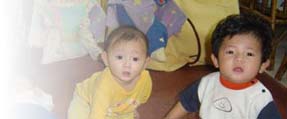 |
|
The indent on top of a baby's head (the fontanel) is where the bones haven't completely grown together. It's covered by a tough membrane and is not easily injured. By about 18 months, it will be closed. |
| Jaundice |
This yellowish tint to baby's skin occurs when a substance called bilirubin builds up faster than the baby's liver can break it down. If the condition persists, the baby may need treatment with special lights. |
| Spotty skin |
Plugged pores can cause little white spots on the baby's face. They will fade away in time. |
| Stork bites |
These pink, brown or red stains on the back of baby's neck will likely go away by about 18 months. |
| Mongolian spot |
A large bluish-gray mark on the baby's back is common among babies of Asian or African ancestry. It will likely disappear by age 5. |
| Bruises |
Don't have to be too alarmed. Bruises from delivery will heal eventually. |
| Cradle cap |
This flaky condition on a baby's scalp is caused when the skin produces too much oily sebum. Loosen the scales with baby oil or petroleum jelly, then shampoo scalp and pat dry. |
| Crossed eyes |
Extra folds of skin at the inside corner of the baby's eyes may make him look cross-eyed. Most babies outgrow the condition. |
| Clogged tear ducts |
If baby's eyes look watery or have a discharge, the baby may have clogged tear ducts. Baby is taken to the doctor for consultation. |
| Rashes are common in newborns |
Most will fade with time. |



